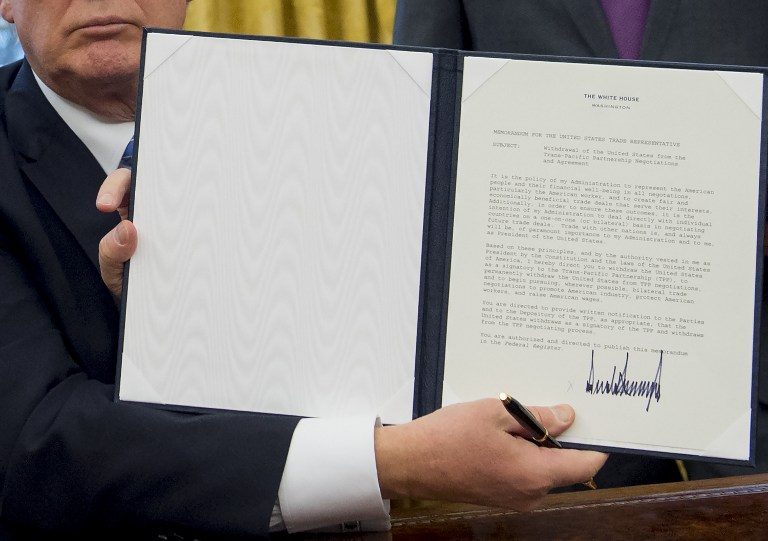SUMMARY
This is AI generated summarization, which may have errors. For context, always refer to the full article.

SYDNEY, Australia (3rd UPDATE) – Australia said Tuesday, January 24, it was working to recast the Trans-Pacific Partnership without the United States and opened the door for China to sign up after President Donald Trump ditched the huge trade pact.
The deal included a dozen Asia-Pacific nations which together account for 40% of the global economy, but Trump declared Monday he had “terminated” it in line with election pledges to scrap the “job killer” pact.
Canberra is floating a “TPP 12 minus one”, with Prime Minister Malcolm Turnbull saying his government was in “active discussions” with other signatories including Japan, New Zealand and Singapore on how to salvage the agreement.
“It is possible that US policy could change over time on this, as it has done on other trade deals,” Turnbull told reporters in Canberra, adding that the nominee for US secretary of state Rex Tillerson and Republicans supported the TPP.
“There is also the opportunity for the TPP to proceed without the United States,” he added.
“Certainly there is the potential for China to join the TPP.”
The agreement, the biggest trade deal in history, was seen as a counter to China’s rising economic influence. It was signed last year but has not gone into effect.
Trade Minister Steven Ciobo said Australia, Canada, Mexico and others had canvassed for a pact without the US at a World Trade Organization ministerial meeting in Davos.
“There would be scope for China if we were able to reformulate it to be a TPP 12 minus one, for countries like Indonesia or China or indeed other countries to consider joining,” Ciobo told the Australian Broadcasting Corporation.
“This is very much a live option and we are pursuing it and it will be the focus of conversations for some time to come.”
New Zealand Prime Minister Bill English noted that Beijing “hasn’t been slow to spot the opportunity” to cast itself as a free trade supporter.
There was a willingness towards “making an effort to find out what we can do with TPP, rather than just dropping it and waiting and hoping to get a call (from Washington) about bilateral agreements sometime”, he told reporters in Wellington.
Trump said he would pursue bilateral deals with TPP signatories to secure terms more favourable to the US. But English said a US-New Zealand pact would be challenging given Trump’s insistence that Washington would dictate terms.
Chinese interest
Beijing has long been noncommittal on the idea of joining the TPP, choosing to back an alternative trade pact, the Regional Comprehensive Economic Partnership (RCEP), a more modest deal that calls for lower and more limited regulatory standards.
It includes the 10 members of the Southeast Asian grouping ASEAN plus China, India, Japan, South Korea, Australia and New Zealand, but notably excludes the US.
At a regular press briefing Tuesday, Chinese foreign ministry spokeswoman Hua Chunying remained coy about Beijing joining the TPP, simply noting that China supports “open, transparent, and win-win” trade pacts.
RCEP talks were pressing ahead, she said, stating they “should be concluded at an early date”.
Alan Oxley, the first Australian to chair the General Agreement on Tariffs and Trade (GATT), the World Trade Organization’s predecessor, said Chinese involvement in the TPP was unlikely at this stage.
“China’s certainly interested in the long run… but the prospect of them tying into the TPP now, given their own domestic economic problems, has got to be considered very low,” Oxley, who heads the Australian APEC Study Centre at RMIT University, told Agence France-Presse.
The most likely option for TPP nations was “let the dust settle” and wait for possible changes in US attitudes towards multilateral pacts, he said.
Analysts in Japan said the TPP would not make sense without the US.
“Japan thinks it’s worth patiently maintaining the (TPP) framework even until the United States possibly comes back to it under the next administration,” Yoko Takeda, chief economist at Mitsubishi Research Institute, told Agence France-Presse.
Trump’s decision to walk away from it “could be a negotiating bluff,” he said. – Rappler.com
Add a comment
How does this make you feel?
There are no comments yet. Add your comment to start the conversation.